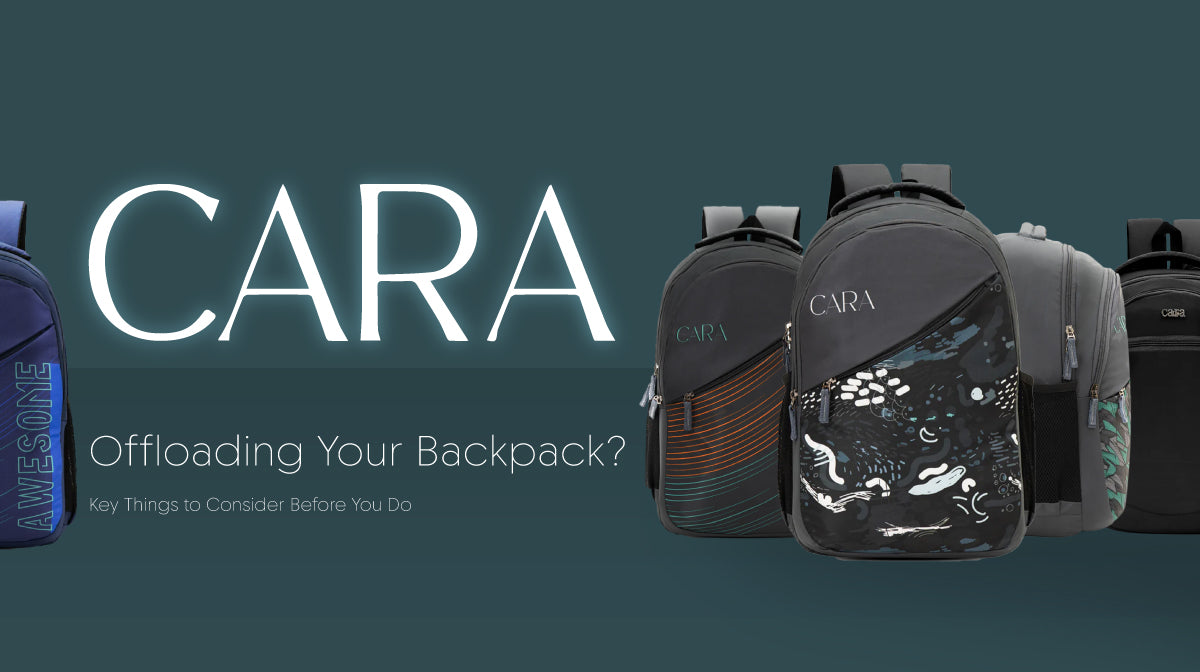
Offloading Your Backpack? Key Things to Consider Before You Do
Trekking has many advantages, including the ability to immerse ourselves in nature, often in close and personal ways, but carrying a fully loaded backpack for hours on rough trails can quickly turn freedom into pain. That's why the idea of backpack offloading exists. If you've never heard of 'backpack offloading', you're not alone.
Backpack offloading simply means that you give up, or remove the things from your big trekking backpack that are not really important. Only carry the small day pack that contains the essentials.
At first sight, it sounds magical: less weight, more comfortable, better energy management. But—it's not always straightforward. The decision to offload your backpack on a trek is both practical and personal. It directly depends on your experience, your capacity for physical endurance, and even your mental stability with the journey.
Whether you are an experienced hiker seeking altitude gain or a new trekker entering the world of trekking, knowing the pros and cons of backpack offloading is crucial. There are numerous factors to consider when deciding whether to offload a backpack, including its impact on physical strain, freedom of movement, associated costs, and how to prepare and pack your day pack intelligently (if you choose to offload). Each factor needs consideration!
So, before you rush to decrease the weight, let’s learn the factors that are crucial in deciding, “Should I offload my backpack trekking or carry it myself?” This blog delves into the logic, logistics, and lessons of offloading for your next adventure.
Whether you are planning a high-altitude trek or a hike, Cara Fashion offers a vast range of stylish and functional backpacks suitable for any type of travel planning.
What is Backpack Offloading?

Backpacking offloading is when you transfer the things from your heavy main trekking backpack to porters, yaks, horses, or mules during the trek. Additionally, you can also remove the extra stuff from the backpack that is no longer in use. This method allows you to carry a lighter daypack with essentials, such as water, snacks, rain gear, sunscreen, and a small first aid kit.
This method is very popular during long, multi-day high-altitude treks, such as Roopkund, Chadar, or Kedarkantha in countries like India. This itinerary is popular due to the nature of the terrain you may encounter.
Although offloading or outsourcing is a luxury, it is often about conserving energy and minimizing the risk of injury. For long-distance trekking, including climbing, unstable weather, and reaching the highest point, most outdoor experts recommend that trekkers consider offloading their packs, even if they're new to trekking or have a history of previous injuries.
Offload Backpack Trekking - What is the Right Time for It

There is no standard method for offloading backpacking trekking. It depends on your physical endurance, difficulty, or length of the trek, and your own personal preferences. Here are some situations when offloading makes sense:
Altitude Trekking: The higher you go, the less oxygen is available, and carrying heavy gear will cause you to fatigue more quickly. Offloading helps save energy and reduces the risk of AMS (Acute Mountain Sickness).
Beginners or Casual Trekkers: If you are new to trekking or not accustomed to carrying a backpack with loads of 12-15kg, offloading will help you avoid burnout.
Injury or Health Recovery: Offloading can be helpful in restoring energy or aiding recovery if you are experiencing joint problems, back pain, or recovering from a previous injury.
Photography/content creation: If you are capturing your experience and need your hands free for your camera or some other equipment, offloading helps you to remain nimble and focused.
Multi-day trekking with camping equipment: If your route involves overnight camps or includes tents, sleeping bags, cooking equipment, and other necessary gear, offloading can significantly reduce the overall burden.
Trekkers who are physically fit or minimalist may feel that they do not want to offload, as this allows them to maintain their mental stability and connection to the journey of the trek.
Backpack Offloading - Pros & Cons

Before reading further, let’s understand the backpack offloading pros and cons for better trekking and physical health throughout the journey.
|
Pros |
Cons |
|
Energy Conservation: Trek with less fatigue and better endurance. |
Less Control Over Gear: Limited access to your main supplies during the day. |
|
Reduced Injury Risk: Minimizes pressure on knees, back, and shoulders. |
Additional Cost: Offloading services may be included in your trek budget. |
|
More Enjoyment: You can enjoy the views, click photos, and move freely. |
Dependence on Others: Relies on porters or animals arriving on time. |
|
Improved Pace: Helps maintain a consistent walking speed with fewer breaks. |
Ethical Concerns: Risk of overburdening porters or animals if not handled responsibly. |
If you are challenging your fitness goals, then you can carry your backpack without needing to offload it anywhere else. But, if you are there to enjoy your whole journey without any physical or nervous breakdown, then you must do the backpack offloading at the halfway point.
Should I Offload My Backpack Trekking - Let’s Compare

Still confused between doing it or not? Let’s compare the facts then:
|
Consider Offloading If... |
You Can Skip Offloading If... |
|
🎒 Your backpack weighs over 10–12 kg. |
🎒 You’ve packed light with an ergonomic, balanced load. |
|
🥾 You’re not used to carrying weight for more than 6–7 hours a day. |
🥾 You’re physically fit and trained with trial hikes. |
|
🧗 You’re trekking at high altitudes (above 3000m). |
🧗 You’re on a low-altitude or short-duration trek. |
|
💢 You have joint, back, or knee issues. |
💪 You’re injury-free and confident in handling your gear. |
|
👥 You’re in a mixed-fitness group or with beginners. |
👣 You enjoy self-sufficiency and trekking independently. |
|
📸 You need free hands for the camera or content gear. |
🏕️ You don’t have additional equipment or filming requirements. |
Bonus Tip: Test your backpack before buying it and your physical endurance before going on a real trek. Put some weight in it and try to take a few rounds of your staircase.
Essential Checklist to Manage Offloading

Before anything else, your backpack must have these essentials, otherwise you will suffer a lot in the whole journey:
|
Water Bottles or Energy Drinks |
Snacks or Energy bars |
|
Rain Coat |
First-aid Kit |
|
Sunscreen and Moisturizer |
Mosquitos Repellent |
|
Power Bank |
High beam Torch |
|
Downloaded Map or Route Printout |
Extra Layer of Warm Clothing |
|
Sleeping Bag, if it includes nights |
Local Emergency Numbers |
Be a pro:
-
Go for a lightweight backpack, including features of even weight distribution, belt and padding support.
-
Never overstuff a backpack, whether it is small or large.
-
Store heavier items on the back side of the shelf.
Conclusion
Trekking is just as much about you discovering yourself as it is getting to a summit. One of the most personal decisions you'll encounter on the trail is whether or not you offload your backpack. So, what's the deal with offloading your backpack? It's about allowing you to adjust, enjoy, and push your physical limits without losing the experience!
Offloading is a blessing when the terrain gets tough, or when you want to save your energy for the magical moments - sunrises over the mountain range, the sudden appearance of an alpine lake, the fire sharing with fellowship in base camp.
At the same time, adding a backpack can foster grit and teach important lessons about resilience. There's an incredible sense of ownership when everything you load on your back has been selected, packed, and carried by you.
However, whether you tend towards offloading or end up carrying everything yourself, the key is to be prepared, informed, and outfitted. Conduct trial hikes, familiarize yourself with your gear, and thoroughly research your trek. If you are offloading, ensure you are very intentional with your daypack management. If you aren't offloading, make sure you have a comfortable backpack and that your body is physically conditioned.
At the heart of every trek lies a personal choice—and neither is right nor wrong. It’s simply about what makes your journey better.
Whichever side you fall on, invest in a high-quality daypack that can hold essentials without straining your shoulders. Cara Fashion’s lightweight, breathable trekking bags are a perfect fit for any trek. Explore them now!!
FAQs
1. In trekking, what is backpack offloading?
Transferring your primary trekking backpack to a porter, mule, or support crew so that you just need to carry a smaller daypack filled with necessities like water, food, and rain gear is known as "backpack offloading." It lessens physical strain on lengthy or high-altitude hikes.
2. Do all hikes require me to unload my backpack?
No, not every trek requires offloading backpack trekking. Trek difficulty, altitude, duration, your level of fitness, and bag weight are some of the factors that affect it. It might be easier and more satisfying to carry your own pack for shorter or easier excursions.
3. What are the advantages and disadvantages of offloading a backpack?
Advantages: Promotes comfort, speeds up movement, reduces fatigue, and minimizes the risk of injury.
Disadvantages: These include increased expenses, restricted access to equipment during the hike, a greater reliance on porters, and potential ethical issues if support personnel or animals are overworked.
4. Does offloading incur additional expenses?
Yes, there is usually an additional fee for offloading services. Prices vary depending on the service, region, and duration of the walk. Always check with your trek organizer in advance regarding pricing and service dependability.




